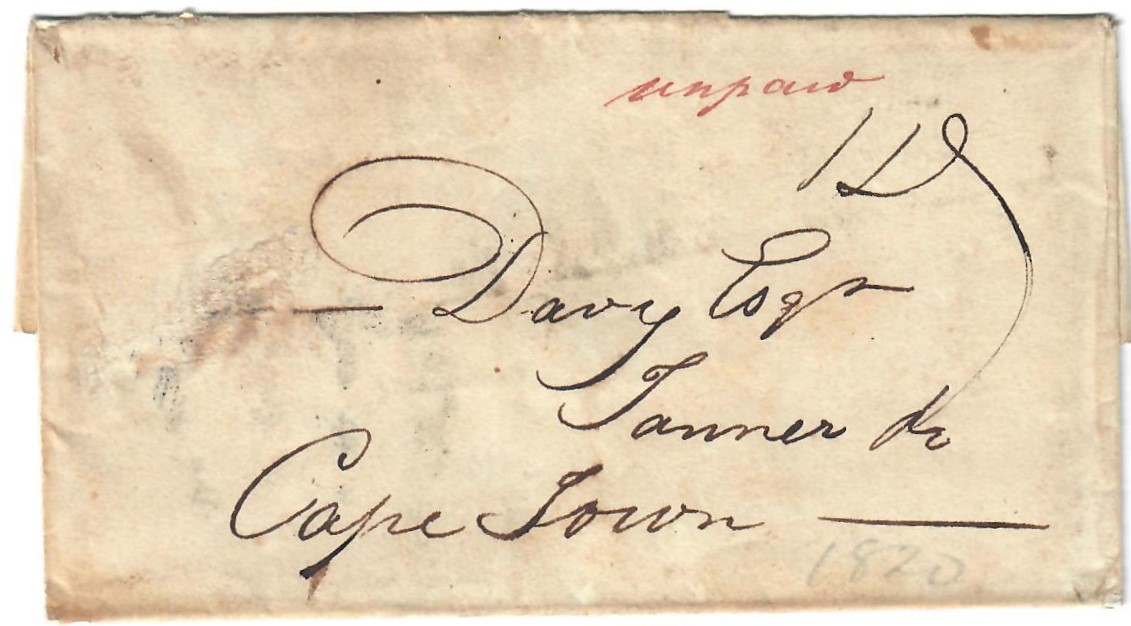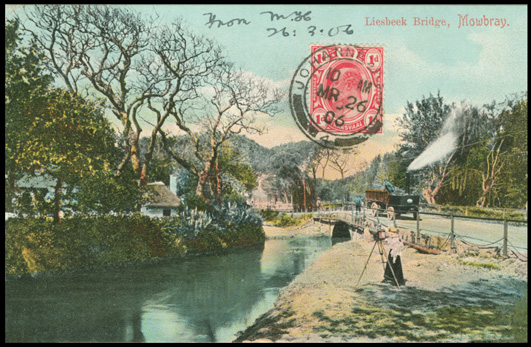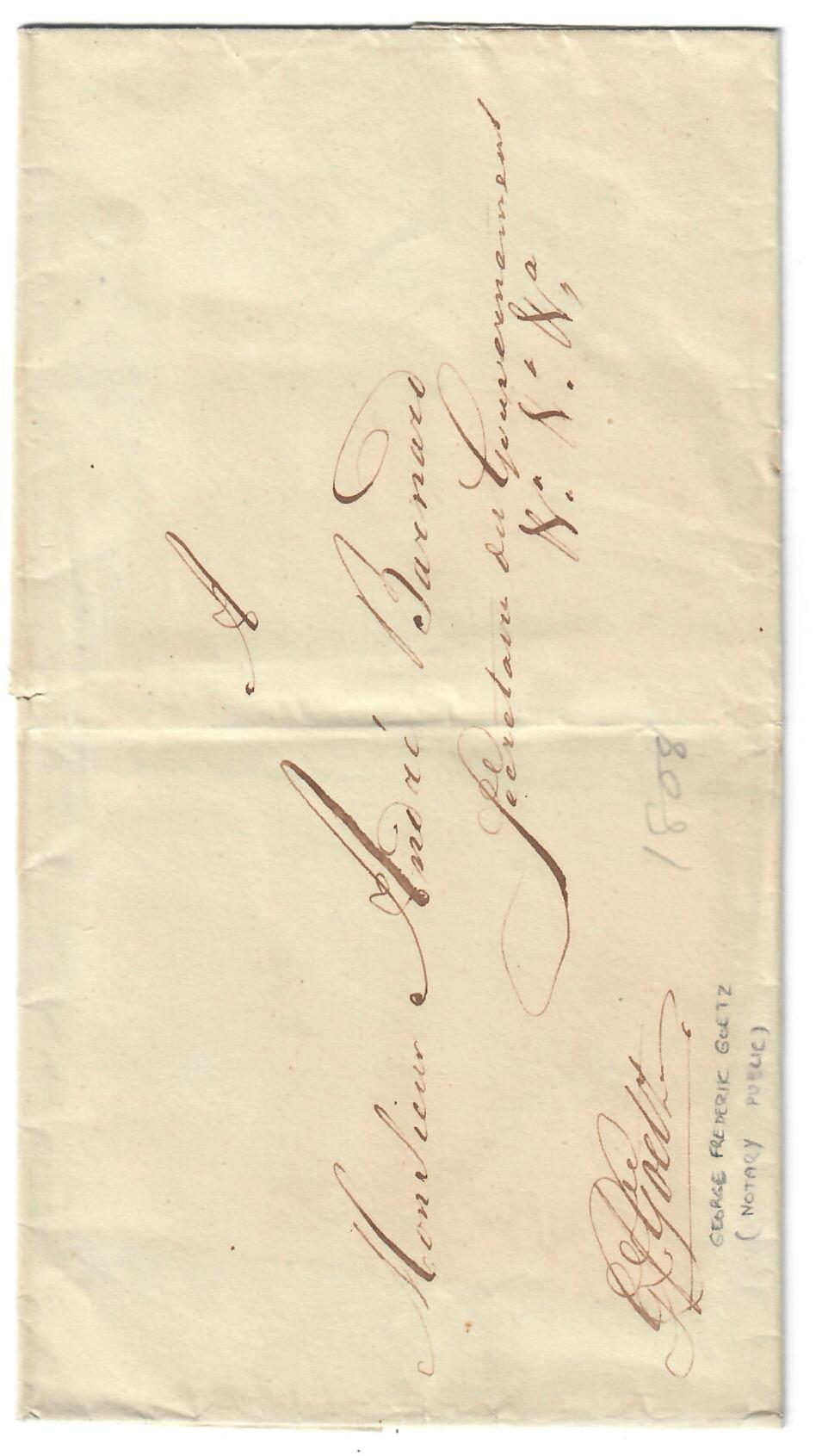Cape of Good Hope: 1820 A tanner named Davy
Quote from yannisl on June 18, 2020, 5:01 pmI attach an interesting and unusual cover and welcome comments from members.
The cover is unusual in that in the lot of 50 or so covers of the period that I have, it is the only one marked in manuscript as unpaid in red ink. There is also a 1/4sk? mark in the same colour and ink as the address. The letter was probably written by a clerk, working in the post office on behalf of the sender.
As was the custom first names sometimes were skipped on letters addressed to the common residents of the Colony. This was the exact opposite for letters addressed to officials and the aristocracy, which had the full name and title of the recipient and sometimes ending in etc. etc. etc. indicating the addressee had more titles.
But how did the letter survive and find its way into the collector market? We know that Botha and Jurgens collaborated to sell items from the archives. Jurgens apparently also saved some items by bribing an official that was destroying them by fire. I exclude the latter possibility due to the pencilled date. I purchased this lot of pre-adhesive wrappers at a Stephan Welz (Sotheby's) auction in Johannesburg 10-15 years ago. As for many such documents the original provenance is unknown.
The first question we need to ask, is if the letter was ever delivered to Davy. If it was delivered then how did it end up in the archives? Wouldn't in this case be in a family or Company archive that was then dispersed? I propose that the letter was delivered and then found its way back in the archives, as part of the Estate of Davy. As we will see later, around the year 1820 Davy died and his estate was wound up by the Orphan Chamber.
I have used two sources to find more information. One is a thesis written by Antonia Malan in 1993, titled Households of the Cape, 1750 to 1850 inventories and the archaeological record. Malan in her study, she used the records of the Orphan Chamber available in the Cape Archives to list the household items of estates and to paint a picture of the day to day life of the people living in the early Cape, based on what items they had in their houses. The second source are the African Court Calendars (De Africaansche staats almanak) of the period.
We fortunate that both sources cite a Davy. In Malan's publication we get to know his first name, where he lived, and what were his major possessions. Joseph Davy appeared to have passed away in 1820 and his estate wound up in the same year by the Orphan Chamber. He had a house on Liesbeeck. At the time of his death he had 16 slaves living in a Slave House belonging to him. He also had a farm with the name Varsschevalley. In his house there was a fireplace, which indicates a more wealthy individual. He had no spouse listed.
From the Almanacs we can find a bit more info. He is first listed in 1813 as having a leathershop at 12 Langemarkt street. There is a similar record for 1814 and 1815. In 1816, 1817 and 1818 he is listed at the same address but as a Tanner. In 1819 he disappears from the Alamanac and his shop is now listed as a leathershop again, belonging to a Roms Pierre. Possibly a sick Davy sold his business to Roms or gave it to him, if they were somehow related.
The street where Davy had his shop is now known as the Longmarket street. The Liesbeeck River where he had his house has a story of its own with the KhoiKhoi living on its banks. With the Dutch occupation the river was slowly cut off and the main reason why the Cape Lion and the Quagga became extinct.
Can someone help to interpret the rate? I am unsure about it. Rates for the period are on page 211 in Goldblatt's book and quoted in Skillings and Stuivers.
I attach an interesting and unusual cover and welcome comments from members.
The cover is unusual in that in the lot of 50 or so covers of the period that I have, it is the only one marked in manuscript as unpaid in red ink. There is also a 1/4sk? mark in the same colour and ink as the address. The letter was probably written by a clerk, working in the post office on behalf of the sender.
As was the custom first names sometimes were skipped on letters addressed to the common residents of the Colony. This was the exact opposite for letters addressed to officials and the aristocracy, which had the full name and title of the recipient and sometimes ending in etc. etc. etc. indicating the addressee had more titles.
But how did the letter survive and find its way into the collector market? We know that Botha and Jurgens collaborated to sell items from the archives. Jurgens apparently also saved some items by bribing an official that was destroying them by fire. I exclude the latter possibility due to the pencilled date. I purchased this lot of pre-adhesive wrappers at a Stephan Welz (Sotheby's) auction in Johannesburg 10-15 years ago. As for many such documents the original provenance is unknown.
The first question we need to ask, is if the letter was ever delivered to Davy. If it was delivered then how did it end up in the archives? Wouldn't in this case be in a family or Company archive that was then dispersed? I propose that the letter was delivered and then found its way back in the archives, as part of the Estate of Davy. As we will see later, around the year 1820 Davy died and his estate was wound up by the Orphan Chamber.
I have used two sources to find more information. One is a thesis written by Antonia Malan in 1993, titled Households of the Cape, 1750 to 1850 inventories and the archaeological record. Malan in her study, she used the records of the Orphan Chamber available in the Cape Archives to list the household items of estates and to paint a picture of the day to day life of the people living in the early Cape, based on what items they had in their houses. The second source are the African Court Calendars (De Africaansche staats almanak) of the period.
We fortunate that both sources cite a Davy. In Malan's publication we get to know his first name, where he lived, and what were his major possessions. Joseph Davy appeared to have passed away in 1820 and his estate wound up in the same year by the Orphan Chamber. He had a house on Liesbeeck. At the time of his death he had 16 slaves living in a Slave House belonging to him. He also had a farm with the name Varsschevalley. In his house there was a fireplace, which indicates a more wealthy individual. He had no spouse listed.
From the Almanacs we can find a bit more info. He is first listed in 1813 as having a leathershop at 12 Langemarkt street. There is a similar record for 1814 and 1815. In 1816, 1817 and 1818 he is listed at the same address but as a Tanner. In 1819 he disappears from the Alamanac and his shop is now listed as a leathershop again, belonging to a Roms Pierre. Possibly a sick Davy sold his business to Roms or gave it to him, if they were somehow related.
The street where Davy had his shop is now known as the Longmarket street. The Liesbeeck River where he had his house has a story of its own with the KhoiKhoi living on its banks. With the Dutch occupation the river was slowly cut off and the main reason why the Cape Lion and the Quagga became extinct.
Can someone help to interpret the rate? I am unsure about it. Rates for the period are on page 211 in Goldblatt's book and quoted in Skillings and Stuivers.
Uploaded files:
Quote from Steve on June 19, 2020, 1:02 pmThank you for a most interesting post. I cannot provide a proper qualified response to your questions. I wish I knew more about rates but, frankly, sometimes I cannot even start to decipher the rate that is written on the covers. Brian Trotter of the South African Collectors' Society has written a book on the subject of rates - Southern African Mails, Routes, Rates and Regulations 1806-1916, (published by the RPSL, UK, 2017). Perhaps the answer lies therein?
As I remember the covers I have which appear to have come from the Cape Archives were all annotated with the dates on the left in a slightly smaller handwriting than yours which is larger and on the right. However, I guess that the annotated date would have been placed where there was open space ie. not over a postmark if that was at bottom left. Sadly, while I made a note of the annotated dates, I made the decision, almost certainly the wrong one, to erase the dates on the covers I had. As a result, I cannot confirm that all the covers I had with annotated notes appeared on the left. Further, I cannot accurately state where my covers came from. I can only guess.
I do like your comment on naming conventions. I have a cover to Lord Charles Somerset, almost certainly from the archives, which has a string of etceteras after his name. However, I note from a quick skwizz of some of my covers that the Dutch era ones usually have the name in full and that the British era ones seem to be much the same, except where the the person is an official, like 'Clerke Burton'. For me, your Davy cover is unusual in that it has only a surname and, importantly, an occupation to describe him. Perhaps much of this depends on the person addressing the letter, the Dutch being politer and more egalitarian than the aristocratic, busy Brits.
Finally, the Liesbeeck River. (Sorry, I digress, again!) This was one of my favourite haunts as a boy in the late 1950s. I have been collecting material relevant to the river and its history. I attach a postcard of the the Raapenberg Road Bridge in 'Little Mowbray'. A steam-driven vehicle is crossing the bridge. As I recall, there was a run-down farmhouse right on the near corner that had a babboon chained to a post. It would go ballistic whenever we walked by. It was terrifying. Whoever took this photograph was standing within twenty metres of that old farm. Who knows, 150 years earlier it may have been Davy's place.
Thank you for a most interesting post. I cannot provide a proper qualified response to your questions. I wish I knew more about rates but, frankly, sometimes I cannot even start to decipher the rate that is written on the covers. Brian Trotter of the South African Collectors' Society has written a book on the subject of rates - Southern African Mails, Routes, Rates and Regulations 1806-1916, (published by the RPSL, UK, 2017). Perhaps the answer lies therein?
As I remember the covers I have which appear to have come from the Cape Archives were all annotated with the dates on the left in a slightly smaller handwriting than yours which is larger and on the right. However, I guess that the annotated date would have been placed where there was open space ie. not over a postmark if that was at bottom left. Sadly, while I made a note of the annotated dates, I made the decision, almost certainly the wrong one, to erase the dates on the covers I had. As a result, I cannot confirm that all the covers I had with annotated notes appeared on the left. Further, I cannot accurately state where my covers came from. I can only guess.
I do like your comment on naming conventions. I have a cover to Lord Charles Somerset, almost certainly from the archives, which has a string of etceteras after his name. However, I note from a quick skwizz of some of my covers that the Dutch era ones usually have the name in full and that the British era ones seem to be much the same, except where the the person is an official, like 'Clerke Burton'. For me, your Davy cover is unusual in that it has only a surname and, importantly, an occupation to describe him. Perhaps much of this depends on the person addressing the letter, the Dutch being politer and more egalitarian than the aristocratic, busy Brits.
Finally, the Liesbeeck River. (Sorry, I digress, again!) This was one of my favourite haunts as a boy in the late 1950s. I have been collecting material relevant to the river and its history. I attach a postcard of the the Raapenberg Road Bridge in 'Little Mowbray'. A steam-driven vehicle is crossing the bridge. As I recall, there was a run-down farmhouse right on the near corner that had a babboon chained to a post. It would go ballistic whenever we walked by. It was terrifying. Whoever took this photograph was standing within twenty metres of that old farm. Who knows, 150 years earlier it may have been Davy's place.
Uploaded files:Quote from yannisl on June 19, 2020, 7:12 pmSteve, thanks for adding the nice postcard and the hint on rates. Indeed the difficulty is to decipher the handwriting. After I wrote the post, I did some more research on Davy. In the archive his surname is spelled as Joseph Davij.
A word of caution also on penciled dates. Some of them might not be accurate, but close to the actual date. Case in hand is the attached wrapper.
The wrapper is addressed to Andre Barnard, Secretary to the Government etc. The wrapper bears the marks of a briefstock letter and was probably was conveyed using a Hottentot runner. On the left is the signature of George Frederick Coetz who was a notary public. There is penciled mark dating the letter to 1808, however this must be incorrect as Barnard died in October 1807. The letter also is a good example with the etc. after the title.
Steve, thanks for adding the nice postcard and the hint on rates. Indeed the difficulty is to decipher the handwriting. After I wrote the post, I did some more research on Davy. In the archive his surname is spelled as Joseph Davij.
A word of caution also on penciled dates. Some of them might not be accurate, but close to the actual date. Case in hand is the attached wrapper.
The wrapper is addressed to Andre Barnard, Secretary to the Government etc. The wrapper bears the marks of a briefstock letter and was probably was conveyed using a Hottentot runner. On the left is the signature of George Frederick Coetz who was a notary public. There is penciled mark dating the letter to 1808, however this must be incorrect as Barnard died in October 1807. The letter also is a good example with the etc. after the title.
Uploaded files:


